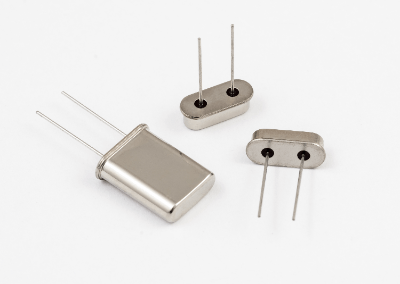What Is an Oscillator?
 An Oscillator is a circuit that uses electronic circuitry to generate a sustained alternating current signal.
An Oscillator is a circuit that uses electronic circuitry to generate a sustained alternating current signal.
It is also called an oscillator or oscillation circuit. A sine wave of a certain frequency is generated. There are several types of oscillator circuits: RC oscillator circuits that combine a resistor (R) and a capacitor (C), oscillator circuits that use a crystal or ceramic resonator, and LC oscillator circuits that combine a coil (L) and a capacitor (C) and utilize their resonance, which are used according to the application.
Uses of Oscillators
Oscillators are used to obtain the transmitting and receiving frequencies for broadcasting and communications equipment.
In broadcasting, program information modulated by radio waves of a specified frequency is transmitted, and the receiver receives radio waves of that frequency to reproduce the program content.
Similarly in the field of communications, information can be exchanged by transmitting at a fixed frequency and tuning to that frequency at the receiving end. In digital circuits, including microprocessors, the system clock that synchronizes the logic circuits plays an important role, and oscillators are used as a source of stable frequencies on which the system clock is based.
In addition, the sound source of an electronic musical instrument also forms the timbre of the instrument based on the signal of the oscillator.
Principle of Oscillator
Oscillator circuits include RC oscillators, which combine a bandpass filter and feedback amplification circuit to output a sine wave in the low-frequency range, and LC oscillator circuits and crystal oscillator circuits, which use the resonance phenomenon to output a sine wave in the high-frequency range.
This section describes mainly crystal oscillator circuits.
1. Quartz Crystal Unit
Quartz crystal units are pure reactance elements with almost no loss in terms of electrical characteristics. Since its reactance is inductive (coil characteristic) only within a very narrow frequency range, connecting a capacitor to the crystal unit determines the resonant frequency within that frequency range.
In the typical Colpitts Oscillator configuration of LC oscillators, if the coil is replaced with a crystal unit, oscillation occurs only within the narrow range where the crystal unit is inductive.
2. Ceramic Crystal Unit
The manufacturing cost of quartz crystal units is high because the oscillation frequency is determined by high-precision processing of the mineral quartz crystal. Therefore, ceramic oscillation circuits using relatively inexpensive ceramic resonators have also been adopted.
Ceramic resonators also exhibit inductive reactance in a specific frequency range, but the disadvantage is that their characteristics are not as steep as those of quartz crystals, and the accuracy of the oscillation frequency is inferior.
3. Quartz Crystal Resonators for Watches and Clocks
Both quartz and ceramic crystal units have oscillation frequencies in the range of several hundred KHz to several tens of MHz, but there is a 32.768 KHz crystal unit for watches and clocks.
Since frequency accuracy is important in oscillation circuits for watches and clocks, ceramic crystal units are not used.
Other Information on Oscillators
Oscillator Related Products
1. Quartz crystal units and ceramic resonators
These are components sold as stand-alone units and are used in connection with integrated circuits with built-in oscillation circuits.
2. Oscillators
Oscillators are sold as components that combine an oscillation circuit and a crystal unit in a single package. Since products with various oscillation frequencies are available for different applications, select the one with the required frequency. The most common type of oscillator is one that converts a sine wave to a square wave for output as a clock for digital circuits.
3. Frequency synthesizer
Variable oscillation frequency is required for communication equipment, etc., but the oscillation frequency is fixed with a crystal oscillator alone. For such applications, frequency synthesizers can be used.
4. Signal generator
One type of electronic measuring instrument is a signal generator with a variable frequency. Most of them use RC oscillator circuits for low-frequency applications and frequency synthesizers for high-frequency applications.